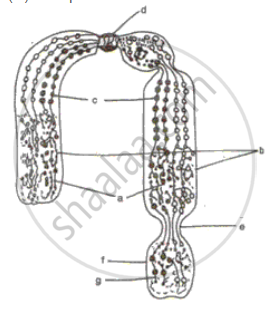Advertisements
Advertisements
Question
Label the lettered parts of the given figure and answer the following questions:
(i) What does this diagram represent?
(ii) What is the importance of'd'?
(iii) What are the 'staining' properties of 'b' and 'c'?
(iv) Who gave the term used for this structure today?
(v) What is a?
(vi) Is 'e' present in all chromosomes?

Solution
(i) This diagram represents the structure of chromosome.
(ii) 'd' is centromere which gets attached to the spindle fibres.
(iii) 'b' is heterochromatin which is darkly stained region when stained with acetocarmine and 'c' is euchromatin which when stained with acetocarmine or felugen gets lightly stained.
(iv) Waldeyer
(v) Matrix
(vi) No, secondary constriction or 'e' is not present in all chromosomes.
APPEARS IN
RELATED QUESTIONS
Chromosomes get aligned at the centre of the cell during:
A. Metaphase
B. Anaphase
C. Prophase
D. Telophase
Name the following:
The number of chromosomes present in a nerve cell of a human being.
Correct the following statement if there is any mistake:
If there are 46 chromosomes in a cell, there will be 23 chromatin fibres inside the nucleus during interphase.
Fill in the blank
The _______ (s) are surrounded by radiating rays called aster
Mention whether the following statement is (T) Or (F). Give reason in support of your answer.
The unfertilized human egg has half the number of chromosomes of the body cells.
Choose the correct answer:
Centromere is related to _______________
Choose the correct answer:
During mitosis which of the following disintegrate ___________
Choose the correct answer:
If after karyokinesis, cytokinesis does not occur, then result would be _____________
Synthesis phase in the cell cycle is called so for the synthesis of more of
What is the importance of meiosis in creating variations?
Differentiate between
Gametic meiosis and Zygotic meiosis.
Differentiate between
Cytokinesis in plant and animal cell
Column ‘II’ is a list of items related to ideas in Column ‘I’. Match the term in Column ‘II’ with a suitable idea given in Column ‘I’.
| Column I | Column II |
| Genetics | Chromosomes are similar in size and shape. |
| Autosomes | The alternative forms of a gene. |
| Recessive gene | Study of laws of inheritance of characters |
| Allele | A gene that can express only when in a similar pair. |
| Homologous chromosomes | Chromosomes are other than the pair of sex chromosomes. |
In humans, the sex chromosome complement is
Explain the structure of chromosomes with labelled diagram.
A male gorilla has 48 chromosomes in each of its body cells. How many chromosomes will each of the sperms have?

Given below is a set of four term. Choose the odd one and write the category of the remaining term:
